Page 3169 of 6020
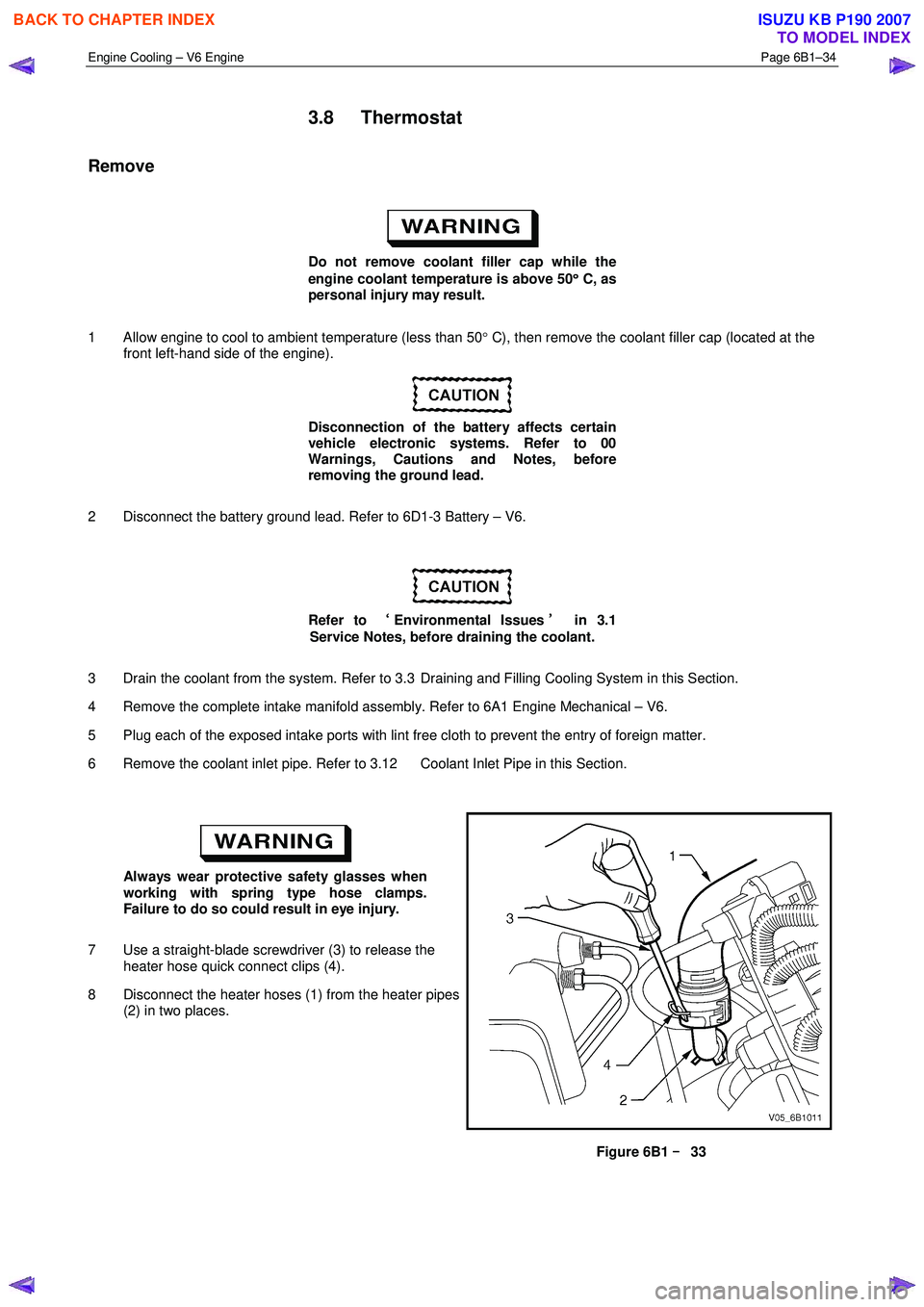
Engine Cooling – V6 Engine Page 6B1–34
3.8 Thermostat
Remove
Do not remove coolant filler cap while the
engine coolant temperature is above 50 °
°°
°
C, as
personal injury may result.
1 Allow engine to cool to ambient temperature (less than 50 ° C), then remove the coolant filler cap (located at the
front left-hand side of the engine).
Disconnection of the battery affects certain
vehicle electronic systems. Refer to 00
Warnings, Cautions and Notes, before
removing the ground lead.
2 Disconnect the battery ground lead. Refer to 6D1-3 Battery – V6.
Refer to ‘
‘‘
‘
Environmental Issues ’
’’
’
in 3.1
Service Notes, before draining the coolant.
3 Drain the coolant from the system. Refer to 3.3 Draining and Filling Cooling System in this Section.
4 Remove the complete intake manifold assembly. Refer to 6A1 Engine Mechanical – V6.
5 Plug each of the exposed intake ports with lint free cloth to prevent the entry of foreign matter.
6 Remove the coolant inlet pipe. Refer to 3.12 Coolant Inlet Pipe in this Section.
Always wear protective safety glasses when
working with spring type hose clamps.
Failure to do so could result in eye injury.
7 Use a straight-blade screwdriver (3) to release the heater hose quick connect clips (4).
8 Disconnect the heater hoses (1) from the heater pipes (2) in two places.
Figure 6B1 –
––
–
33
BACK TO CHAPTER INDEX
TO MODEL INDEX
ISUZU KB P190 2007
Page 3170 of 6020
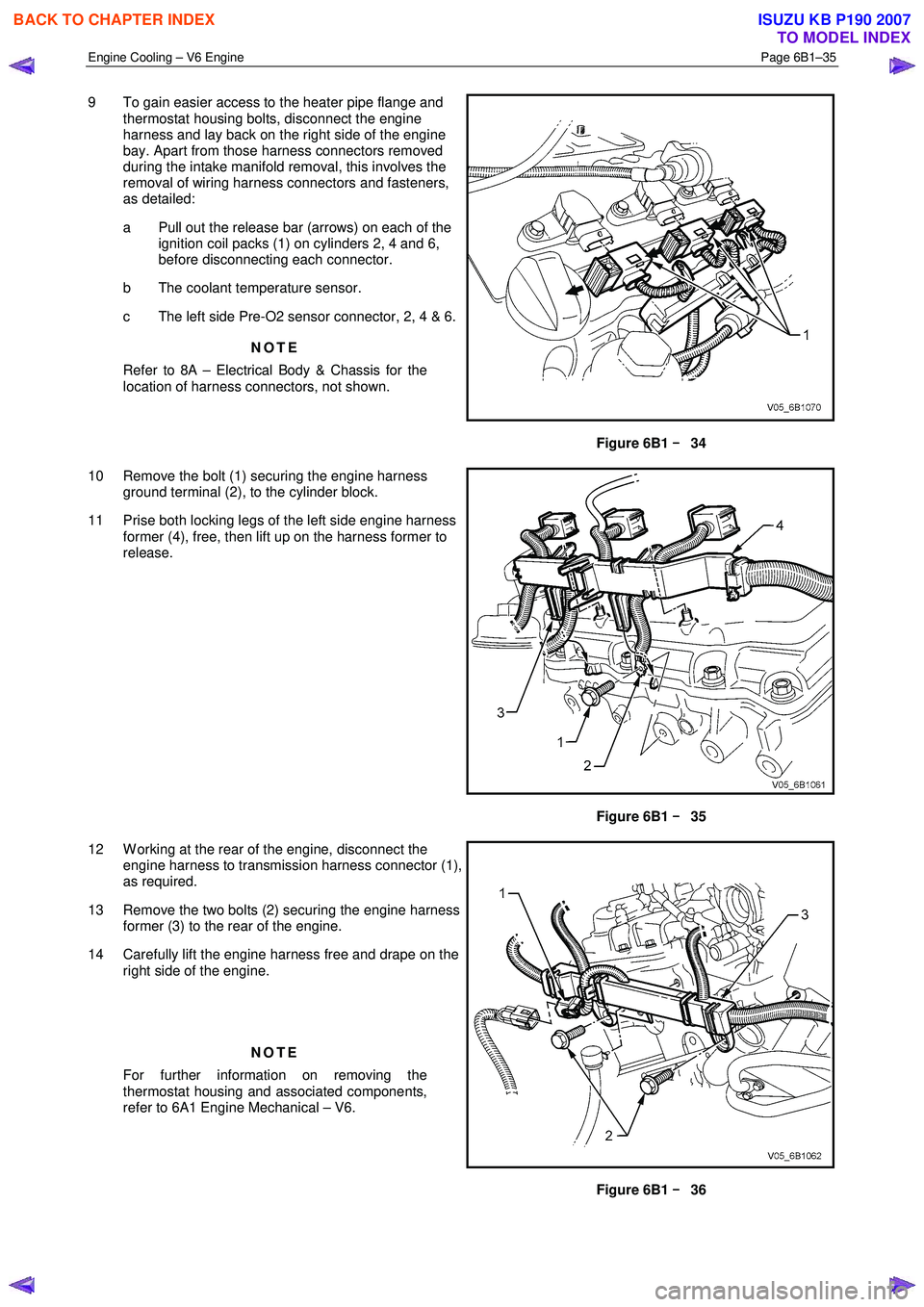
Engine Cooling – V6 Engine Page 6B1–35
9 To gain easier access to the heater pipe flange and
thermostat housing bolts, disconnect the engine
harness and lay back on the right side of the engine
bay. Apart from those harness connectors removed
during the intake manifold removal, this involves the
removal of wiring harness connectors and fasteners,
as detailed:
a Pull out the release bar (arrows) on each of the ignition coil packs (1) on cylinders 2, 4 and 6,
before disconnecting each connector.
b The coolant temperature sensor.
c The left side Pre-O2 sensor connector, 2, 4 & 6.
NOTE
Refer to 8A – Electrical Body & Chassis for the
location of harness connectors, not shown.
Figure 6B1 –
––
–
34
10 Remove the bolt (1) securing the engine harness ground terminal (2), to the cylinder block.
11 Prise both locking legs of the left side engine harness former (4), free, then lift up on the harness former to
release.
Figure 6B1 –
––
–
35
12 W orking at the rear of the engine, disconnect the engine harness to transmission harness connector (1),
as required.
13 Remove the two bolts (2) securing the engine harness former (3) to the rear of the engine.
14 Carefully lift the engine harness free and drape on the right side of the engine.
NOTE
For further information on removing the
thermostat housing and associated components,
refer to 6A1 Engine Mechanical – V6.
Figure 6B1 –
––
–
36
BACK TO CHAPTER INDEX
TO MODEL INDEX
ISUZU KB P190 2007
Page 3172 of 6020
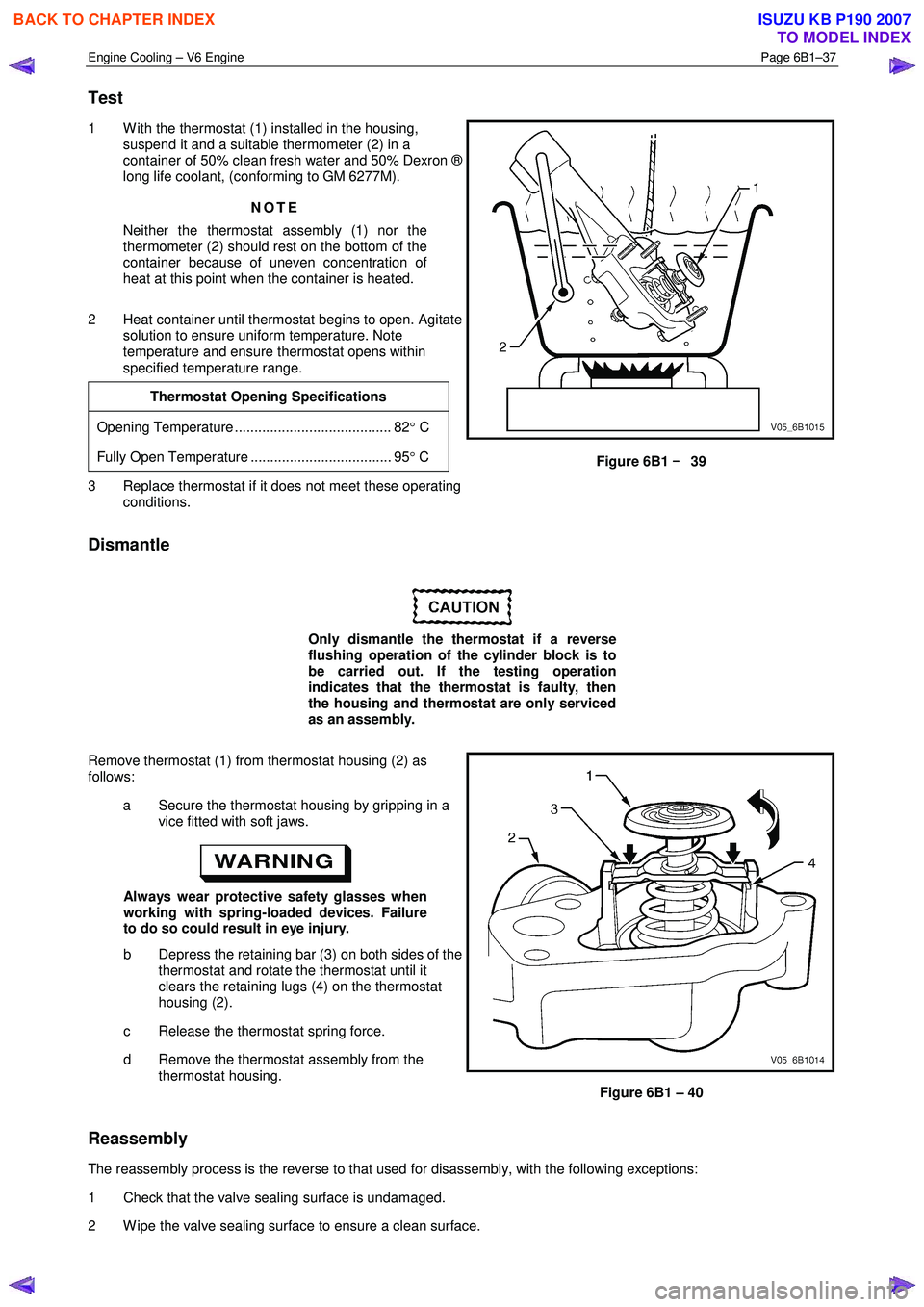
Engine Cooling – V6 Engine Page 6B1–37
Test
1 W ith the thermostat (1) installed in the housing,
suspend it and a suitable thermometer (2) in a
container of 50% clean fresh water and 50% Dexron ®
long life coolant, (conforming to GM 6277M).
NOTE
Neither the thermostat assembly (1) nor the
thermometer (2) should rest on the bottom of the
container because of uneven concentration of
heat at this point when the container is heated.
2 Heat container until thermostat begins to open. Agitate solution to ensure uniform temperature. Note
temperature and ensure thermostat opens within
specified temperature range.
Thermostat Opening Specifications
Opening Temperature ........................................ 82 ° C
Fully Open Temperature .................................... 95 ° C
3 Replace thermostat if it does not meet these operating
conditions.
Figure 6B1 –
––
–
39
Dismantle
Only dismantle the thermostat if a reverse
flushing operation of the cylinder block is to
be carried out. If the testing operation
indicates that the thermostat is faulty, then
the housing and thermostat are only serviced
as an assembly.
Remove thermostat (1) from thermostat housing (2) as
follows:
a Secure the thermostat housing by gripping in a vice fitted with soft jaws.
Always wear protective safety glasses when
working with spring-loaded devices. Failure
to do so could result in eye injury.
b Depress the retaining bar (3) on both sides of the thermostat and rotate the thermostat until it
clears the retaining lugs (4) on the thermostat
housing (2).
c Release the thermostat spring force.
d Remove the thermostat assembly from the thermostat housing.
Figure 6B1 – 40
Reassembly
The reassembly process is the reverse to that used for disassembly, with the following exceptions:
1 Check that the valve sealing surface is undamaged.
2 W ipe the valve sealing surface to ensure a clean surface.
BACK TO CHAPTER INDEX
TO MODEL INDEX
ISUZU KB P190 2007
Page 3175 of 6020
Engine Cooling – V6 Engine Page 6B1–40
2 Check coolant recovery system for leaks.
3.10 Coolant Pump
Remove
Refer to 3.1 Service Notes in this Section, for
important safety items.
NOTE
The coolant pump is not to be disassembled and
is replaced only as an assembly.
1 Allow engine to cool to ambient temperature (less than 50 ° C), and then remove the coolant filler cap (located at
the front left-hand side of the engine).
Disconnection of the battery affects certain
vehicle electronic systems. Refer to 1.1
WARNING, CAUTION and NOTES, before
removing the ground lead.
2 Disconnect the battery ground lead. Refer to 8A – Electrical Body & Chassis.
3 Loosen coolant pump pulley to hub bolts (1).
NOTE
While the view shows the drive belt removed,
it will be easier to loosen the four pulley bolts,
with the belt installed.
Figure 6B1 – 42
BACK TO CHAPTER INDEX
TO MODEL INDEX
ISUZU KB P190 2007
Page 3180 of 6020
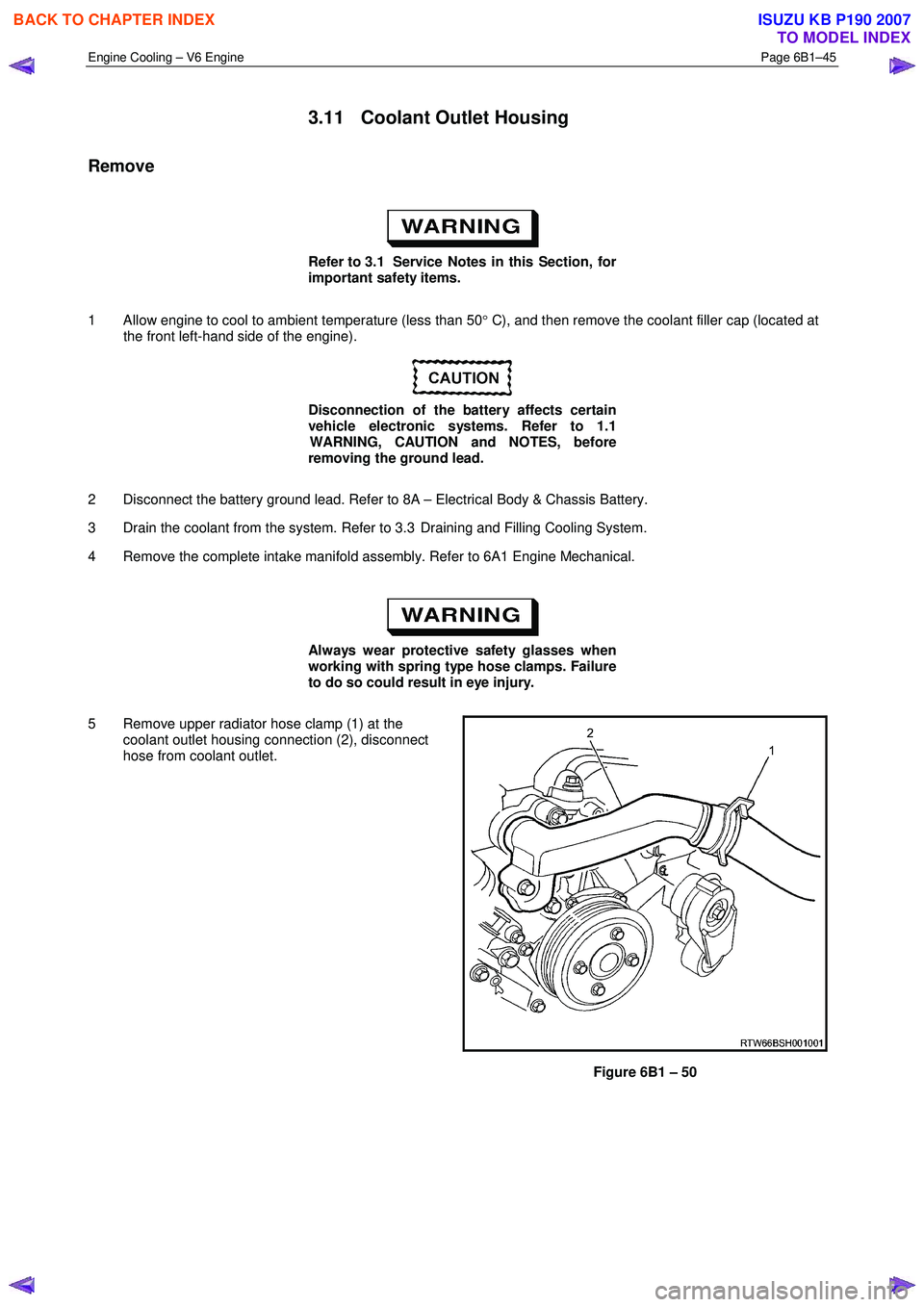
Engine Cooling – V6 Engine Page 6B1–45
3.11 Coolant Outlet Housing
Remove
Refer to 3.1 Service Notes in this Section, for
important safety items.
1 Allow engine to cool to ambient temperature (less than 50 ° C), and then remove the coolant filler cap (located at
the front left-hand side of the engine).
Disconnection of the battery affects certain
vehicle electronic systems. Refer to 1.1
WARNING, CAUTION and NOTES, before
removing the ground lead.
2 Disconnect the battery ground lead. Refer to 8A – Electrical Body & Chassis Battery.
3 Drain the coolant from the system. Refer to 3.3 Draining and Filling Cooling System.
4 Remove the complete intake manifold assembly. Refer to 6A1 Engine Mechanical.
Always wear protective safety glasses when
working with spring type hose clamps. Failure
to do so could result in eye injury.
5 Remove upper radiator hose clamp (1) at the coolant outlet housing connection (2), disconnect
hose from coolant outlet.
Figure 6B1 – 50
BACK TO CHAPTER INDEX
TO MODEL INDEX
ISUZU KB P190 2007
Page 3181 of 6020

Engine Cooling – V6 Engine Page 6B1–46
6 Remove the two coolant outlet housing attaching
bolts (1), and remove coolant outlet housing (2).
7 Remove and discard coolant outlet housing O-ring (3) and seal (4).
Figure 6B1 – 51
Reinstall
1 Ensure that the coolant outlet housing and front outlet mating surfaces are clean and dry.
2 Install new O-ring and seal to coolant outlet housing.
3 Install coolant outlet housing and attaching bolts. Tighten all bolts to the correct torque specification.
Coolant outlet housing to front
outlet bolt torque specification..............................10 N.m
Always wear protective safety glasses when
working with spring type hose clamps. Failure
to do so could result in eye injury.
4 Connect the upper radiator hose and clamp to the coolant outlet housing connection.
5 Close the radiator drain tap on the lower RHS of the radiator and remove the piece of rubber tubing to the tap outlet.
6 Reinstall the intake manifold assembly. Refer to 6A1 Engine Mechanical.
7 Refill cooling system. Refer to 3.3 Draining and Filling Cooling System in this Section.
8 Check for coolant leaks. Refer to 3.7 Pressure Testing in this Section.
9 Reconnect battery ground lead. Refer to 8A – Electrical Body & Chassis.
3.12 Coolant Inlet Pipe
Remove
Refer to 3.1 Service Notes in this Section, for
important safety items.
1 Allow engine to cool to ambient temperature (less than 50 ° C), and then remove the coolant filler cap (located at
the front left-hand side of the engine).
BACK TO CHAPTER INDEX
TO MODEL INDEX
ISUZU KB P190 2007
Page 3189 of 6020
Engine Cooling – V6 Engine Page 6B1–54
3.15 Radiator
Remove
Refer to 3.1 Service Notes in this Section, for
important safety items.
1 Allow engine to cool to ambient temperature (less than 50 ° C), then remove coolant filler cap.
Disconnection of the battery affects certain
vehicle electronic systems. Refer to 00
Warnings, Cautions and Notes, before
removing the ground lead.
2 Disconnect the battery ground lead. Refer to 8A – Electrical Body & Chassis.
3 Depress the tang on the main wiring harness to the cooling fan motor wiring harness connector (1) and
separate the connector.
4 Remove the radiator cooling fan and shroud assembly. Refer to 3.13 Cooling Fan and Shroud
Assembly in this Section.
5 Drain the coolant from the system. Refer to 3.3 Draining and Filling Cooling System in this
Section.
Refer to ‘
‘‘
‘
Environmental Issues ’
’’
’
in 3.1
Service Notes, before draining the
coolant.
Figure 6B1 – 62
BACK TO CHAPTER INDEX
TO MODEL INDEX
ISUZU KB P190 2007
Page 3194 of 6020
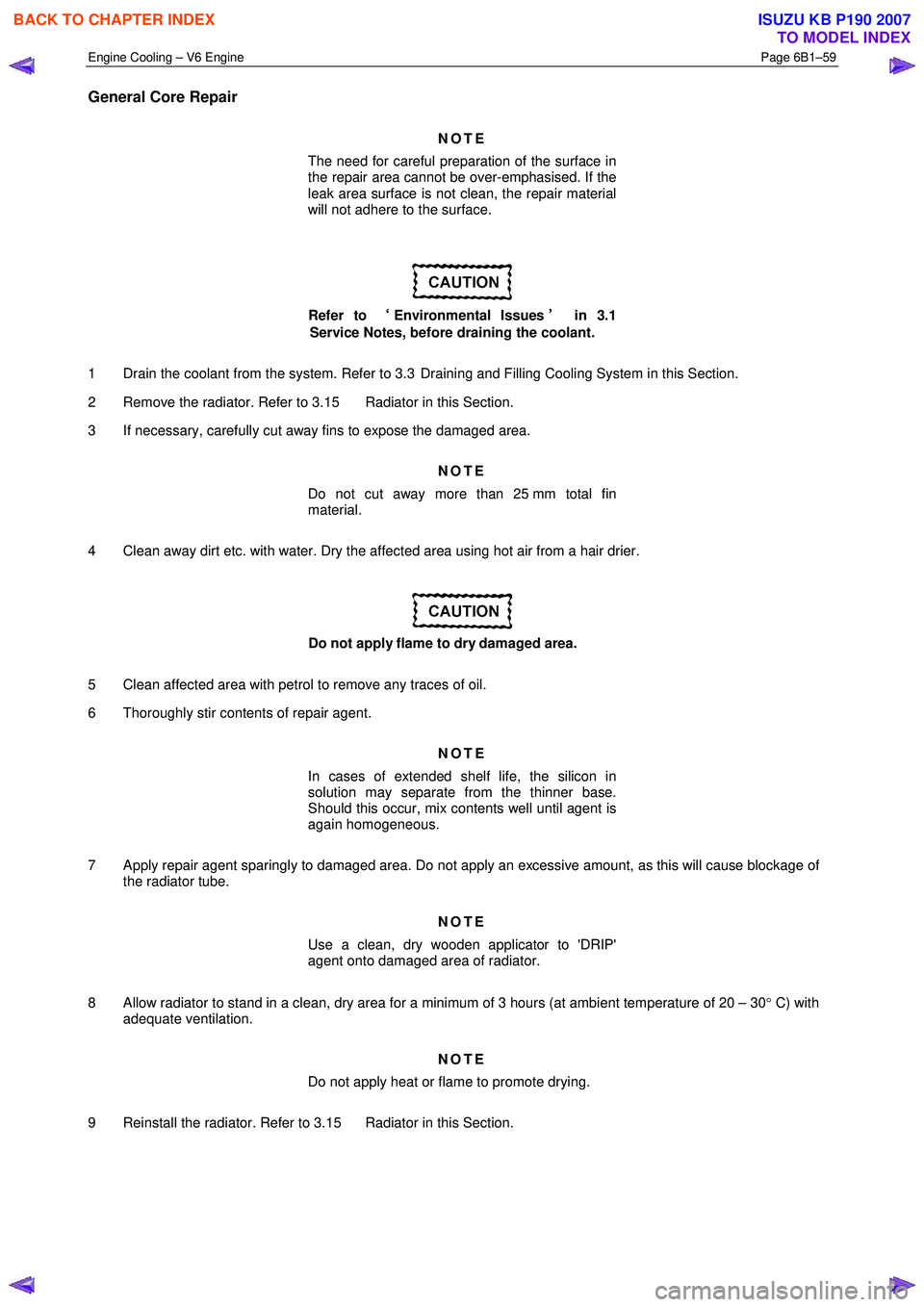
Engine Cooling – V6 Engine Page 6B1–59
General Core Repair
NOTE
The need for careful preparation of the surface in
the repair area cannot be over-emphasised. If the
leak area surface is not clean, the repair material
will not adhere to the surface.
Refer to ‘
‘‘
‘
Environmental Issues ’
’’
’
in 3.1
Service Notes, before draining the coolant.
1 Drain the coolant from the system. Refer to 3.3 Draining and Filling Cooling System in this Section.
2 Remove the radiator. Refer to 3.15 Radiator in this Section.
3 If necessary, carefully cut away fins to expose the damaged area.
NOTE
Do not cut away more than 25 mm total fin
material.
4 Clean away dirt etc. with water. Dry the affected area using hot air from a hair drier.
Do not apply flame to dry damaged area.
5 Clean affected area with petrol to remove any traces of oil.
6 Thoroughly stir contents of repair agent.
NOTE
In cases of extended shelf life, the silicon in
solution may separate from the thinner base.
Should this occur, mix contents well until agent is
again homogeneous.
7 Apply repair agent sparingly to damaged area. Do not apply an excessive amount, as this will cause blockage of the radiator tube.
NOTE
Use a clean, dry wooden applicator to 'DRIP'
agent onto damaged area of radiator.
8 Allow radiator to stand in a clean, dry area for a minimum of 3 hours (at ambient temperature of 20 – 30 ° C) with
adequate ventilation.
NOTE
Do not apply heat or flame to promote drying.
9 Reinstall the radiator. Refer to 3.15 Radiator in this Section.
BACK TO CHAPTER INDEX
TO MODEL INDEX
ISUZU KB P190 2007